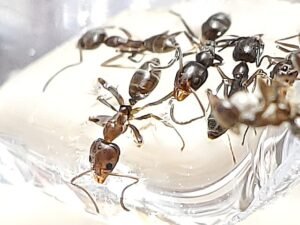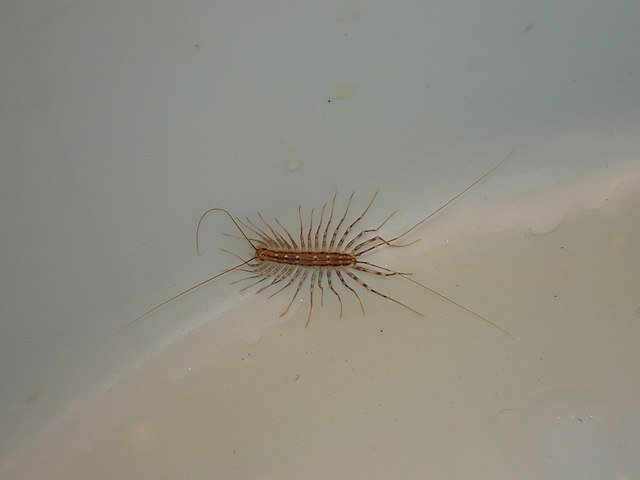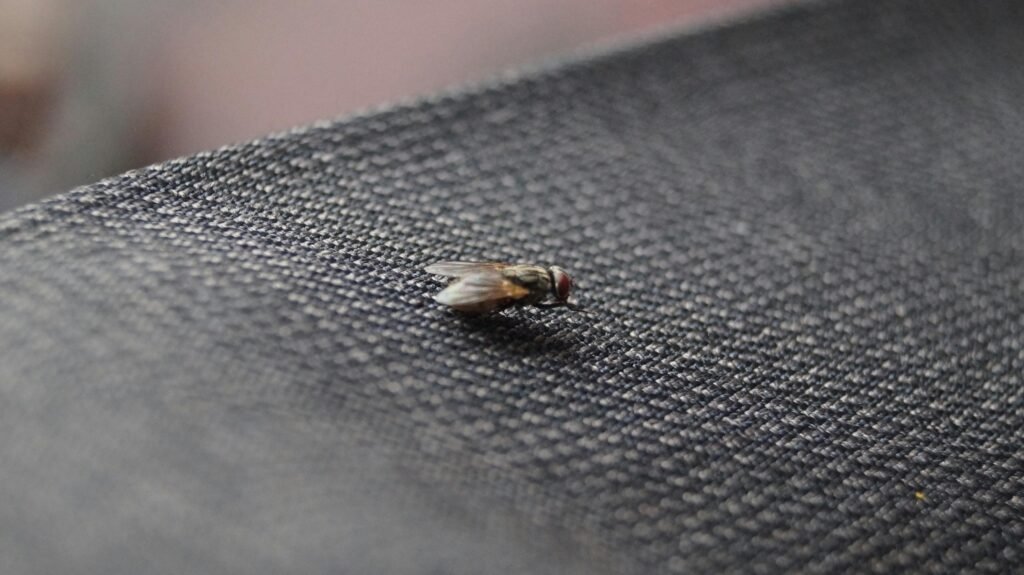Argentine Ants: Identification, Biology, Risks, and Control
 The Argentine ant (Linepithema humile) is one of the most studied invasive ants worldwide. Originally from South America, it has successfully colonized multiple continents, outcompeting native ants and creating massive ecological changes. Unlike smaller local species such as the pavement ant (Tetramorium immigrans), Argentine ants form supercolonies that stretch for hundreds of kilometers.
The Argentine ant (Linepithema humile) is one of the most studied invasive ants worldwide. Originally from South America, it has successfully colonized multiple continents, outcompeting native ants and creating massive ecological changes. Unlike smaller local species such as the pavement ant (Tetramorium immigrans), Argentine ants form supercolonies that stretch for hundreds of kilometers.
These ants are notorious not only for their ability to infest homes but also for their broader impact on ecosystems, agriculture, and urban infrastructure. Their cooperation across colonies makes them one of the most challenging pests to control.
Identification
Accurate identification is the foundation of any pest control plan. Argentine ants can be confused with species such as the odorous house ant (Tapinoma sessile) or the pharaoh ant (Monomorium pharaonis), but there are key features:
Size: Workers are 2.2–2.6 mm long, all of similar size (monomorphic).
Color: Light to dark brown, with a shiny appearance.
Antennae: 12 segments, no club.
Petiole: One node between thorax and gaster.
Odor: When crushed, they emit a musty, greasy smell.
Movement: Trails are tight and well-organized, unlike the chaotic motion of tawny crazy ants (Nylanderia fulva).
Colonies are typically found outdoors in soil, mulch, and under debris, but they frequently invade kitchens, bathrooms, and pantries in search of food.
Biology and Ecology
The success of Linepithema humile lies in its unique biology.
Supercolonies: Colonies cooperate instead of fighting, forming massive networks with multiple queens.
Reproduction: New nests are created by budding, not mating flights. This makes spread slow but relentless.
Diet: Omnivorous. Feed on sweet substances like honeydew from aphids and scale insects, but also scavenge protein from dead insects or household scraps.
Nest sites: Prefer moist soil, especially near irrigation systems, plant roots, or building foundations.
Activity patterns: Highly active in warm months, retreating deeper into soil during cold seasons.
Their ecological strategy is simple: cooperate, spread locally, and monopolize resources.
Global Distribution
Native to the Paraná River region in Argentina and Brazil, Linepithema humile has spread globally.
Europe: Established along the Mediterranean coast, especially Spain, Portugal, France, and Italy.
North America: Southern U.S. states (California, Texas, Louisiana, Georgia) and some urban centers further north.
Oceania: Widespread in Australia and New Zealand.
Asia and Africa: Localized populations near trade hubs and ports.
Colonization is strongly tied to human activity. Ships and commerce spread them, and once introduced, they thrive in irrigated farms and urban landscapes.
Risks and Damage
Ecological damage
Displace native ants like the harvester ant (Pogonomyrmex spp.) and carpenter ants (Camponotus spp.).
Reduce diversity of arthropods and small invertebrates.
Indirectly harm vertebrates such as lizards, ground-nesting birds, and even some amphibians by removing their insect prey.
Agricultural impact
Protect honeydew-producing insects such as aphids, mealybugs, and whiteflies.
Increase outbreaks of pests in citrus, vineyards, and ornamental plants.
Raise pesticide costs for farmers.
Household and structural issues
Invade homes in search of sweets, fats, and proteins.
Nest in potted plants, insulation, and crawlspaces.
Contaminate food and create nuisance infestations.
Signs of Infestation
Argentine ant infestations have recognizable indicators:
Long, visible trails: Dense lines of ants moving between nest and food.
Sudden food invasions: Especially sweets left uncovered.
Outdoor density: Heavy presence in moist garden beds, mulch, or irrigation areas.
Seasonal shifts: Ants retreat indoors during dry or cold conditions.
Lack of native ants: Argentine ants often replace local species entirely.
Control Methods
Chemical approaches
Residual sprays: Limited effectiveness due to colony size and multiple queens.
Baits: Carbohydrate-based baits (boric acid, thiamethoxam, or fipronil formulations) work if applied consistently.
Protein-based baits: Useful during brood-rearing phases.
Cultural practices
Seal food sources in homes.
Remove yard debris and reduce moisture levels.
Eliminate honeydew-producing insects from gardens.
Professional tools
Use of insect growth regulators (IGRs) to reduce colony reproduction.
Wide-area baiting programs in agriculture and urban districts.
Advanced Approaches
Integrated pest management (IPM) is essential against Argentine ants.
Rotation of baits: Colonies change preferences between sugar and protein depending on season.
Barrier treatments: Perimeter insecticide applications prevent indoor invasion.
Landscape design: Minimizing excessive mulch, maintaining dry soil, and trimming vegetation reduce nesting opportunities.
Biological research: Studies explore fungal pathogens, nematodes, and pheromone disruption as future tools.
A major challenge is their supercolony structure: unless large populations are suppressed simultaneously, smaller subgroups repopulate the area.
Cultural and Historical Context
The Argentine ant has influenced more than biology—it has shaped human response to invasive species.
In California, its spread in the early 20th century disrupted agriculture, leading to some of the earliest large-scale ant control experiments.
The concept of “supercolony” in scientific literature largely comes from studying Linepithema humile.
In Mediterranean Europe, locals often describe the species as an unstoppable household nuisance, with seasonal news coverage on outbreaks.
Their cultural impact lies in reminding communities of how trade and globalization can unintentionally spread ecological problems.
FAQ Section
Q1: Do Argentine ants bite or sting?
They do not sting. Bites are rare and generally harmless. Their nuisance value comes from sheer numbers.
Q2: Why are Argentine ants so invasive?
They form cooperative supercolonies with multiple queens, eliminating intraspecific competition and outnumbering native species.
Q3: How long can Argentine ant colonies survive?
Supercolonies can persist for decades, continuously expanding if conditions remain favorable.
Q4: Are Argentine ants dangerous to crops?
Yes. By protecting aphids and scale insects, they indirectly damage citrus, grapes, and other crops.
Q5: What is the best way to get rid of Argentine ants indoors?
Use slow-acting baits placed along trails, combined with sealing entry points and maintaining strict sanitation.
Q6: Can Argentine ants be permanently eradicated?
Local populations can be reduced, but complete eradication is rare once they are established in a region.
Q7: What weather conditions do Argentine ants prefer?
Moist, temperate environments. They avoid extremely dry or cold climates but can survive in irrigated landscapes.
Q8: How do Argentine ants interact with other invasive ants?
They often displace smaller species but can lose ground to aggressive species like Nylanderia fulva in some habitats.
Final Thoughts
The Argentine ant (Linepithema humile) remains one of the most successful invasive ants worldwide. Its cooperative supercolony system, reliance on honeydew from other insects, and ability to adapt to urban and agricultural environments make it difficult to control.
While their presence may seem like a nuisance at first, the broader consequences include loss of biodiversity, crop damage, and long-term infestations in cities. Effective management requires consistent baiting programs, reduction of food sources, and professional monitoring. Research into biological controls and pheromone disruption may offer future solutions, but at present, integrated pest management remains the most reliable approach.
Disclaimer
This article is for informational purposes only. Pest control laws and approved chemicals vary by country. For best results and legal safety, we strongly recommend contacting a licensed pest control professional in your local area. Always make sure that the pest control technician is properly certified or licensed, depending on your country’s regulations. It’s important to confirm that they only use approved products and apply them exactly as instructed on the product label. In most places in Europe, UK, or USA, following label directions is not just best practice—it’s the law.
Author Bio
Nasos Iliopoulos
BSc Agronomist & Certified Pest Control Expert
Scientific Director – Advance Services (Athens, Greece)
Licensed Pest Control Business – Ministry of Rural Development & Food (GR)
References
Wikipedia - Argentine ants
University of California) - Argentine ants


